Beko BCHA 2752 S User Manual [ru]

Refrigerator BCHA2752S Холодильник-морозильник
Šaldytuvas Ledusskapis

Please read this manual first!
Dear Customer,
We hope that your product, which has been produced in modern plants and checked under the most meticulous quality control procedures, will provide you an effective service.
For this, we recommend you to carefully read the entire manual of your product before using it and keep it at hand for future references.
This manual
•Will help you use your appliance in a fast and safe way.
•Read the manual before installing and operating your product.
•Follow the instructions, especially those for safety.
•Keep the manual in an easily accessible place as you may need it later.
•Besides, read also the other documents provided with your product. Please note that this manual may be valid for other models as well.
Symbols and their descriptions
This instruction manual contains the following symbols:
C Important information or useful usage tips.
AWarning against dangerous conditions for life and property.
BWarning against electric voltage.
This product is supplied with the selective sorting symbol for waste electrical Recycling and electronic equipment (WEEE).
This means that this product must be handled pursuant to European Directive
2002/96/EC in order to be recycled or dismantled to minimise its impact on the environment. For further information, please contact your local or regional authorities.
Electronic products not included in the selective sorting process are potentially dangerous for the environment and human health due to the presence of hazardous substances.

CONTENTS
1 |
Your refrigerator |
3 |
2 |
Important Safety |
|
Warnings |
4 |
|
Intended use...................................... |
4 |
|
General safety.................................... |
4 |
|
Child safety........................................ |
6 |
|
HCA Warning..................................... |
6 |
|
Things to be done for energy saving... |
7 |
|
Technical specifications of your |
|
|
refrigerator......................................... |
7 |
|
5 Using your refrigerator 13
Thermostat setting button................ |
13 |
Defrost............................................. |
13 |
Zero temperature compartment........ |
14 |
6 Maintenance and |
|
cleaning |
15 |
Protection of plastic surfaces .......... |
15 |
7 Recommended solutions |
|
for the problems |
16 |
3 Installation |
8 |
Points to be considered when re- |
|
transporting your refrigerator.............. |
8 |
Before operating your refrigerator....... |
8 |
Disposing of the packaging................ |
9 |
Disposing of your old refrigerator........ |
9 |
Placing and Installation....................... |
9 |
Replacing the interior light bulb ....... |
10 |
Reversing the doors......................... |
11 |
4 Preparation |
12 |
2EN
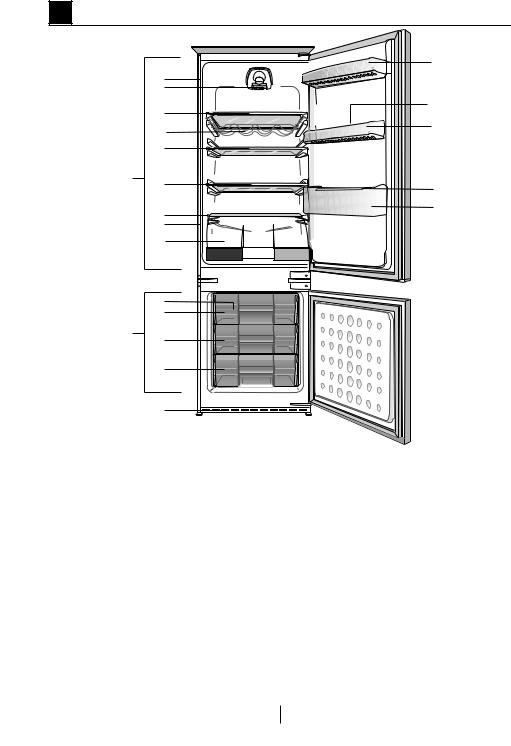
1 |
Your refrigerator |
|
|
|
10 |
|
1 |
|
|
2 |
|
|
|
11 |
|
3 |
|
|
13 |
10 |
|
|
|
|
3 |
|
|
14 |
|
|
3 |
13 |
|
|
|
|
5 |
12 |
|
|
|
|
4 |
|
|
6 |
|
7
8
15 |
8 |
|
|
|
8 |
|
9 |
1. |
Temperature setting knob |
8. |
Freezer compartment |
2. |
Interior light |
9. |
Air grille |
3. |
Adjustable shelves |
10. Adjustable door shelves |
|
4. |
Defrost water collection channel - |
11. |
Egg tray |
|
Drain tube |
12. |
Bottle shelf |
5. |
Crisper cover |
13. |
Bottle holder |
6. |
0 °C Compartment |
14. |
Fridge compartment |
7. |
Ice bank |
15. |
Freezer compartment |
C Figures that take place in this instruction manual are schematic and may not correspond exactly with your product. If the subject parts are not included in the product you have purchased, then it is valid for other models.
3 EN

2 |
Important Safety Warnings |
|||
Please review the following information. |
• For products with a freezer |
|
||
Failure to observe this information may |
compartment; Do not put bottled and |
|||
canned liquid beverages in the freezer |
||||
cause injuries or material damage. |
||||
compartment. Otherwise, these may |
||||
Otherwise, all warranty and reliability |
||||
burst. |
||||
commitments will become invalid. |
||||
• Do not touch frozen food by hand; |
||||
Original Spare parts will be provided |
||||
they may stick to your hand. |
||||
for 10 years, following the product |
||||
• Unplug your refrigerator before |
||||
purchasing date. |
||||
cleaning or defrosting. |
||||
|
|
|||
Intended use |
• Vapor and vaporized cleaning |
|||
This product is intended to be used |
materials should never be used in |
|||
– indoors and in closed areas such as |
cleaning and defrosting processes of |
|||
homes; |
your refrigerator. In such cases, the |
|||
– in closed working environments such |
vapor may get in contact with the |
|||
as stores and offices; |
electrical parts and cause short circuit |
|||
– in closed accommodation areas such |
or electric shock. |
|||
as farm houses, hotels, pensions. |
• Never use the parts on your |
|||
• This product should not be used |
refrigerator such as the door as a |
|||
outdoors. |
means of support or step. |
|||
General safety |
• Do not use electrical devices inside |
|||
the refrigerator. |
||||
• When you want to dispose/scrap |
• Do not damage the parts, where |
|||
the product, we recommend you to |
the refrigerant is circulating, with |
|||
consult the authorized service in order |
drilling or cutting tools. The refrigerant |
|||
to learn the required information and |
that might blow out when the gas |
|||
authorized bodies. |
channels of the evaporator, pipe |
|||
• Consult your authorized service for |
extensions or surface coatings are |
|||
all your questions and problems |
punctured causes skin irritations and |
|||
related to the refrigerator. Do not |
eye injuries. |
|||
intervene or let someone intervene to |
• Do not cover or block the ventilation |
|||
the refrigerator without notifying the |
holes on your refrigerator with any |
|||
authorised services. |
material. |
|||
• For products with a freezer |
• Electrical devices must be repaired |
|||
compartment; Do not eat cone ice |
by only authorised persons. Repairs |
|||
cream and ice cubes immediately |
performed by incompetent persons |
|||
after you take them out of the freezer |
create a risk for the user. |
|||
compartment! (This may cause |
• In case of any failure or during |
|||
frostbite in your mouth.) |
a maintenance or repair work, |
|||
|
|
disconnect your refrigerator’s mains |
||
supply by either turning off the relevant fuse or unplugging your appliance.
4 EN

•Do not pull by the cable when pulling off the plug.
•Place the beverage with higher proofs tightly closed and vertically.
•Never store spray cans containing flammable and explosive substances in the refrigerator.
•Do not use mechanical devices or other means to accelerate the
defrosting process, other than those recommended by the manufacturer.
•This product is not intended to be used by persons with physical, sensory or mental disorders or unlearned or inexperienced people (including children) unless they are attended by a person who will be responsible for their safety or who will instruct them accordingly for use of the product
•Do not operate a damaged refrigerator. Consult with the service agent if you have any concerns.
•Electrical safety of your refrigerator shall be guaranteed only if the earth system in your house complies with standards.
•Exposing the product to rain, snow, sun and wind is dangerous with respect to electrical safety.
•Contact authorized service when there is a power cable damage to avoid danger.
•Never plug the refrigerator into the wall outlet during installation. Otherwise, risk of death or serious injury may arise.
•This refrigerator is intended for only storing food items. It must not be used for any other purpose.
•Label of technical specifications is located on the left wall inside the refrigerator.
•Never connect your refrigerator to electricity-saving systems; they may damage the refrigerator.
•If there is a blue light on the refrigerator, do not look at the blue light with optical tools.
•For manually controlled refrigerators, wait for at least 5 minutes to start the refrigerator after power failure.
•This operation manual should be handed in to the new owner of the product when it is given to others.
•Avoid causing damage on power cable when transporting the refrigerator. Bending cable may cause fire. Never place heavy objects on power cable. Do not touch the plug with wet hands when plugging the product.
•Do not plug the refrigerator if the wall outlet is loose.
•Water should not be sprayed directly on inner or outer parts of the product for safety purposes.
•Do not spray substances containing inflammable gases such as propane gas near the refrigerator to avoid fire and explosion risk.
•Never place containers filled with water on top of the refrigerator, otherwise this may cause electric shock or fire.
•Do not overload your refrigerator with excessive amounts of food. If overloaded, the food items may fall down and hurt you and damage refrigerator when you open the door.
Never place objects on top of the refrigerator; otherwise, these objects may fall down when you open or close the refrigerator's door.
5EN

•As they require a precise temperature, vaccines, heat-sensitive medicine and scientific materials and etc. should not be kept in the refrigerator.
•If not to be used for a long time, refrigerator should be unplugged. A possible problem in power cable may cause fire.
•The plug's tip should be regularly cleaned; otherwise, it may cause fire.
•Refrigerator may move if adjustable legs are not properly secured on the floor. Properly securing adjustable legs on the floor can prevent the refrigerator to move.
•When carrying the refrigerator, do not hold it from door handle. Otherwise, it may be snapped.
•When you have to place your product next to another refrigerator or freezer, the distance between devices should be at least 8cm. Otherwise, adjacent side walls may be humidified.
For products with a water dispenser;
Pressure of water mains should be minimum 1 bar. Pressure of water mains should be maximum 8 bars.
• Use only potable water.
Child safety
•If the door has a lock, the key should be kept away from reach of children.
•Children must be supervised to prevent them from tampering with the product.
HCA Warning
If your product's cooling system contains R600a:
This gas is flammable. Therefore, pay attention to not damaging the cooling system and piping during usage and transportation. In the event of damage, keep your product away from potential fire sources that can cause the product catch a fire and ventilate the room in which the unit is placed.
Ignore this warning if your product's cooling system contains R134a.
Type of gas used in the product is stated in the type plate which is on the left wall inside the refrigerator.
Never throw the product in fire for disposal.
6EN

Things to be done for energy saving
•Do not leave the doors of your refrigerator open for a long time.
•Do not put hot food or drinks in your refrigerator.
•Do not overload your refrigerator so that the air circulation inside of it is not prevented.
•Do not install your refrigerator under direct sunlight or near heat emitting appliances such as ovens, dishwashers or radiators.
•Pay attention to keep your food in closed containers.
2010-11-xx
Y Y Y Y - M M - D D
•For products with a freezer compartment; You can store maximum amount of food items in the freezer when you remove the shelf or drawer of the freezer. Energy consumption value stated for your refrigerator has been determined
by removing freezer shelf or drawer and under maximum load. There is no harm to use a shelf or drawer
according to the shapes and size of food to be frozen.
•Thawing frozen food in fridge compartment will both provide energy saving and preserve the food quality.
Technical specifications of your refrigerator
Energy e ciency class |
+ |
Protection class |
1 |
|
|
Protection level |
IP 42 |
|
|
7 EN

|
Installation |
|
|
|
3 |
|
|
||
|
|
|
|
|
B Please remember that the |
3. Plug the refrigerator into the wall outlet. |
|||
When the fridge door is open the |
||||
|
manufacturer shall not be held liable if |
|||
|
fridge compartment interior light will |
|||
|
the information given in the instruction |
|||
|
come on. |
|||
|
manual is not observed. |
|||
|
4. You will hear a noise as the |
|||
Points to be considered |
||||
compressor starts up. The liquid and |
||||
when re-transporting your |
||||
gases sealed within the refrigeration |
||||
refrigerator |
||||
system may also give rise to noise, |
||||
1. Your refrigerator must be |
||||
even if the compressor is not running |
||||
|
emptied and cleaned prior to any |
|||
|
and this is quite normal. |
|||
|
transportation. |
|||
|
5. Front edges of the refrigerator may |
|||
2. Shelves, accessories, crisper and etc. |
||||
feel warm. This is normal. These areas |
||||
|
in your refrigerator must be fastened |
|||
|
are designed to be warm to avoid |
|||
|
securely by adhesive tape against any |
|||
|
condensation. |
|||
|
jolt before repackaging. |
|||
|
Electric connection |
|||
3. Packaging must be tied with thick |
||||
Connect your product to a grounded |
||||
|
tapes and strong ropes and the |
|||
|
socket which is being protected by a |
|||
|
rules of transportation printed on the |
|||
|
fuse with the appropriate capacity. |
|||
|
package must be followed. |
|||
|
Important: |
|||
Please do not forget… |
||||
• The connection must be in compliance |
||||
Every recycled material is an |
||||
with national regulations. |
||||
indispensable source for the nature |
||||
• The power cable plug must be easily |
||||
and for our national resources. |
||||
accessible after installation. |
||||
If you wish to contribute to recycling |
||||
• The specified voltage must be equal to |
||||
the packaging materials, you can |
||||
your mains voltage. |
||||
get further information from the |
||||
• Extension cables and multiway plugs |
||||
environmental bodies or local |
||||
must not be used for connection. |
||||
authorities. |
||||
B A damaged power cable must be |
||||
Before operating your |
||||
replaced by a qualified electrician. |
||||
refrigerator |
||||
B Product must not be operated before |
||||
Before starting to use your refrigerator |
||||
check the following: |
it is repaired! There is danger of electric |
|||
1. Is the interior of the refrigerator dry |
shock! |
|||
Disposing of the packaging |
||||
|
and can the air circulate freely in the |
|||
|
The packing materials may be |
|||
|
rear of it? |
|||
|
dangerous for children. Keep the |
|||
2. Clean the interior of the refrigerator as |
||||
|
recommended in the “Maintenance |
packing materials out of the reach |
||
|
of children or dispose them of by |
|||
|
and cleaning” section. |
|||
|
classifying them in accordance |
|||
|
|
|||
|
|
with the waste instructions. Do not |
||
|
|
dispose them of along with the normal |
||
|
|
household waste. |
||
8EN

The packing of your refrigerator is produced from recyclable materials.
Disposing of your old refrigerator
Dispose of your old machine without giving any harm to the environment.
•You may consult your authorized dealer or waste collection center of your municipality about the disposal of your refrigerator.
Before disposing of your refrigerator, cut out the electric plug and, if there are any locks on the door, make them inoperable in order to protect children against any danger.
Placing and Installation
1.Install your refrigerator to a place that allows ease of use.
2.Keep your refrigerator away from heat sources, humid places and direct sunlight.
3.There must be appropriate air ventilation around your refrigerator in order to achieve an efficient operation.
If the refrigerator is to be placed in a recess in the wall, there must be at least 5 cm distance with the ceiling and at least 5 cm with the wall.
If the floor is covered with a carpet, your product must be elevated 2.5 cm from the floor.
4.Place your refrigerator on an even floor surface to prevent jolts.
5.Do not keep your refrigerator in ambient temperatures under 10°C.
C This appliance is designed to operate at temperatures specified in the table below is equipped with Advanced Electronic Temperature Control System [AETCS] which
ensures that at the advised setting [4
- four on the knob] the frozen food in the freezer will not defrost even if the ambient temperature falls as low as -15 °C.
When first installed the product
MUST NOT be placed in low ambient temperatures because the freezer will not reduce to it’s standard operating temperature. Once it has reached its steady operating state it can be relocated.
So you may then install your appliance in a garage or an unheated room without having to worry about frozen food in the freezer being spoilt. However at low ambient temperatures mentioned above, fridge contents are likely to freeze, so check and consume food in the fridge accordingly. When the ambient temperature returns to normal, you may change the knob setting to suit your needs.
C If the ambient temperature is below 0°C, the food in the fridge compartment will freeze.So, we recommend you don’t use the fridge compartment in such low ambient conditions. You can continue using the freezer compartment as usual.
9EN

Replacing the interior light bulb
To change the Bulb/LED used for illumination of your refrigerator, call your AuthorisedService.
The lamp(s) used in this appliance is not suitable for household room illumination. The intended purpose of this lamp is to assist the user to place foodstuffs in the refrigerator/freezer in a safe and comfortable way.
The lamps used in this appliance have to withstand extreme physical conditions such as temperatures below -20°C.
10 EN

Reversing the doors
Proceed in numerical order
2 |
1 |
3 |
|
||
|
|
4 |
|
10 |
|
|
|
5 |
|
|
6 |
|
11 |
7 |
|
12 |
|
|
|
8 |
|
|
9 |
|
13 |
|

 17
17
16
15
|
18 |
14 |
22 |
21 |
|
|
20 |
|
23 |
19 |
|
11 EN

4 Preparation
CYour refrigerator should be installed at least 30 cm away from heat sources such as hobs, ovens, central heater and stoves and at least 5 cm away from electrical ovens and should not be located under direct sunlight.
CThe ambient temperature of the room where you install your
refrigerator should at least be 10°C. Operating your refrigerator under cooler conditions than this is not recommended with regard to its efficiency.
CPlease make sure that the interior of your refrigerator is cleaned thoroughly.
CIf two refrigerators are to be installed side by side, there should be at least 2 cm distance between them.
CWhen you operate your refrigerator for the first time, please observe the following instructions during the initial six hours.
-The door should not be opened frequently.
-It must be operated empty without any food in it.
-Do not unplug your refrigerator. If a power failure occurs out of your control, please see the warnings in the “Recommended solutions for the problems” section.
COriginal packaging and foam materials should be kept for future transportations or moving.
12 EN
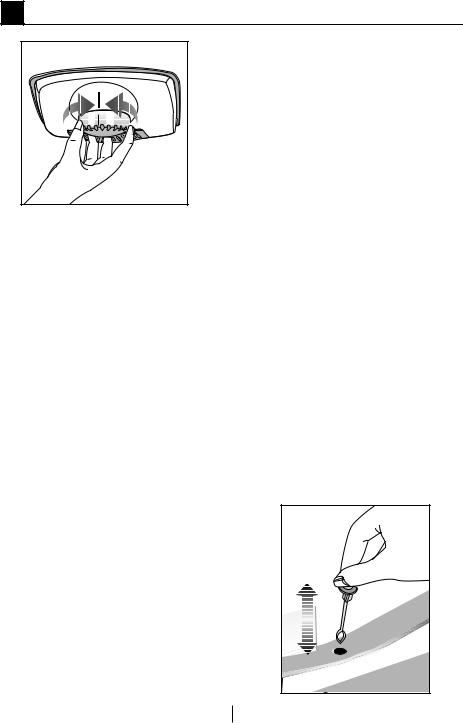
5 Using your refrigerator
Thermostat setting button
The interior temperature of your refrigerator changes for the following reasons;
•Seasonal temperatures,
•Frequent opening of the door and leaving the door open for long periods,
•Food put into the refrigerator without cooling down to the room temperature,
•The location of the refrigerator in the room (e.g. exposing to sunlight).
•You may adjust the varying interior temperature due to such reasons by using the thermostat. Numbers around the thermostat button indicates the cooling degrees.
•If the ambient temperature is higher than 32 °C, turn the thermostat button to maximum position.
•If the ambient temperature is lower than 25 °C, turn the thermostat button to minumum position.
Defrost
Fridge compartment
Fridge compartment performs fullautomatic defrosting. Water drops and a frosting up to 7-8 mm can occur
on the inner rear wall of the fridge compartment while your refrigerator cools down. Such formation is normal as a result of the cooling system.
The frost formation is defrosted by performing automatic defrosting with certain intervals thanks to the
automatic defrosting system of the rear wall. User is not required to scrape the frost or remove the water drops.
Water resulting from the defrosting passes from the water collection groove and flows into the evaporator through the drain pipe and evaporates here by itself.
Check regularly to see if the drain pipe is clogged or not and clear it with the stick in the hole when necessary.
Deep freezer compartment does not perform automatıc defrosting in order to prevent decaying of the frozen food
The freezer compartment defrosts automatically.
13 EN
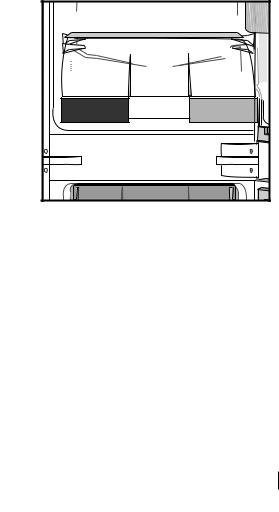
Zero temperature compartment
This compartment has been designed to store frozen food which would be thawed slowly (meat, fish, chicken,etc.) as required.Zero temperature compartment is the coldest place of your refrigerator in
which dairy products (cheese, butter), meat, fish or chicken may be kept at ideal storage conditions.Vegetables and/or fruits must not be placed in this compartment.
14 EN

6 Maintenance and cleaning
A Never use gasoline, benzene or similar substances for cleaning purposes.
B We recommend that you unplug the appliance before cleaning.
B Never use any sharp abrasive instrument, soap, household cleaner, detergent and wax polish for cleaning.
CUse lukewarm water to clean the cabinet of your refrigerator and wipe it dry.
CUse a damp cloth wrung out in a solution of one teaspoon of bicarbonate of soda to one pint of
water to clean the interior and wipe it dry.
B Make sure that no water enters the lamp housing and other electrical items.
B If your refrigerator is not going to be used for a long period of time, unplug the power cable, remove all food, clean it and leave the door ajar.
CCheck door seals regularly to ensure they are clean and free from food particles.
A To remove door racks, remove all the contents and then simply push the door rack upwards from the base.
Protection of plastic surfaces
CDo not put the liquid oils or oil-cooked meals in your refrigerator in unsealed containers as they damage the plastic surfaces of your refrigerator. In case of spilling or smearing oil on the plastic surfaces, clean and rinse the relevant part of the surface at once with warm water.
15 EN
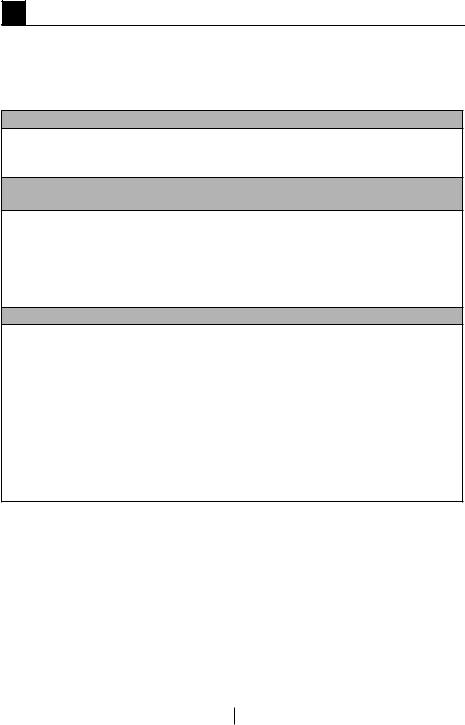
7 Recommended solutions for the problems
Please review this list before calling the service. It might save you time and money. This list includes frequent complaints that are not arising from defective workmanship or material usage. Some of the features described here may not exist in your product.
The refrigerator does not operate.
•Is the refrigerator properly plugged in? Insert the plug to the wall socket.
•Is the fuse of the socket which your refrigerator is connected to or the main fuse blown out? Check the fuse.
Condensation on the side wall of the fridge compartment (MULTIZONE, COOL CONTROL and FLEXI ZONE).
•Very cold ambient conditions. Frequent opening and closing of the door. Highly humid ambient conditions. Storage of food containing liquid in open containers.
Leaving the door ajar. Switching the thermostat to a colder degree.
•Decreasing the time the door left open or using it less frequently.
•Covering the food stored in open containers with a suitable material.
•Wipe the condensation using a dry cloth and check if it persists.
Compressor is not running
•Protective thermic of the compressor will blow out during sudden power failures or plug-out plug-ins as the refrigerant pressure in the cooling system of the refrigerator has not been balanced yet. Your refrigerator will start running approximately after 6 minutes. Please call the service if the refrigerator does not startup at the end of this period.
•The fridge is in defrost cycle. This is normal for a full-automatically defrosting refrigerator. Defrosting cycle occurs periodically.
•Your refrigerator is not plugged into the socket. Make sure that the plug is properly fit into the socket.
•Are the temperature adjustments correctly made?
•Power might be cut off.
16 EN
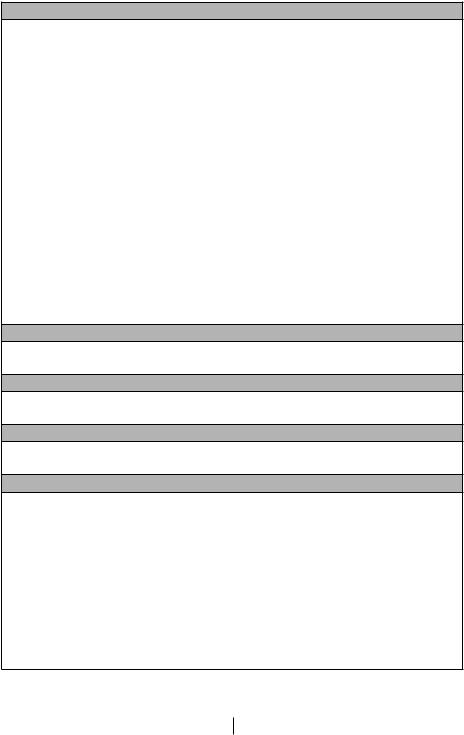
The fridge is running frequently or for a long time.
•Your new product may be wider than the previous one. This is quite normal. Large refrigerators operate for a longer period of time.
•The ambient room temperature may be high. This is quite normal.
•The refrigerator might have been plugged in recently or might have been loaded with food. Cooling down of the refrigerator completely may last for a couple of hours longer.
•Large amounts of hot food might have been put in the refrigerator recently. Hot food causes longer running of the refrigerator until they reach the safe storage temperature.
•Doors might have been opened frequently or left ajar for a long time. The warm air that has entered into the refrigerator causes the refrigerator to run for longer periods. Open the doors less frequently.
•Freezer or fridge compartment door might have been left ajar. Check if the doors are tightly closed.
•The refrigerator is adjusted to a very low temperature. Adjust the refrigerator temperature to a warmer degree and wait until the temperature is achieved.
•Door seal of the fridge or freezer may be soiled, worn out, broken or not properly seated. Clean or replace the seal. Damaged/broken seal causes the refrigerator to run for a longer period of time in order to maintain the current temperature.
Freezer temperature is very low while the fridge temperature is sufficient.
•The freezer temperature is adjusted to a very low temperature. Adjust the freezer temperature to a warmer degree and check.
Fridge temperature is very low while the freezer temperature is sufficient.
•The fridge temperature might have been adjusted to a very low temperature.
Adjust the fridge temperature to a warmer degree and check.
Food kept in the fridge compartment drawers are freezing.
•The fridge temperature might have been adjusted to a very low temperature.
Adjust the fridge temperature to a warmer degree and check.
Temperature in the fridge or freezer is very high.
•The fridge temperature might have been adjusted to a very high degree.
Fridge adjustment has an effect on the temperature of the freezer. Change the temperature of the fridge or freezer until the fridge or freezer temperature reaches to a sufficient level.
•Doors might have been opened frequently or left ajar for a long time; open them less frequently.
•Door might have been left ajar; close the door completely.
•Large amount of hot food might have been put in the refrigerator recently. Wait until the fridge or freezer reaches the desired temperature.
•The refrigerator might have been plugged in recently. Cooling down of the refrigerator completely takes time.
17 EN
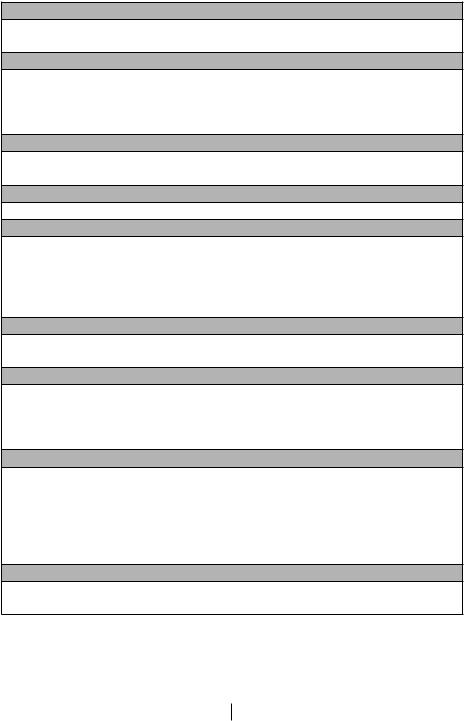
The operation noise increases when the refrigerator is running.
•The operating performance of the refrigerator may change due to the changes in the ambient temperature. It is normal and not a fault.
Vibrations or noise.
•The floor is not even or it is weak. The refrigerator rocks when moved slowly.
Make sure that the floor is strong enough to carry the refrigerator, and level.
•The noise may be caused by the items put onto the refrigerator. Items on top of the refrigerator should be removed.
There are noises coming from the refrigerator like liquid spilling or spraying.
•Liquid and gas flows happen in accordance with the operating principles of your refrigerator. It is normal and not a fault.
There is a noise like wind blowing.
•Fans are used in order to cool the refrigerator. It is normal and not a fault.
Condensation on the inner walls of refrigerator.
•Hot and humid weather increases icing and condensation. It is normal and not a fault.
•Doors might have been left ajar; make sure that the doors are closed fully.
•Doors might have been opened frequently or left ajar for a long time; open them less frequently.
Humidity occurs on the outside of the refrigerator or between the doors.
•There might be humidity in the air; this is quite normal in humid weather. When the humidity is less, condensation will disappear.
Bad odor inside the refrigerator.
•Inside of the refrigerator must be cleaned. Clean the inside of the refrigerator with a sponge, lukewarm water or carbonated water.
•Some containers or package materials might cause the smell. Use a different container or different brand packaging material.
The door is not closing.
•Food packages may prevent the door's closing. Replace the packages that are obstructing the door.
•The refrigerator is not completely upright on the floor and rocking when slightly moved. Adjust the elevation screws.
•The floor is not level or strong. Make sure that the floor is level and capable to carry the refrigerator.
Crispers are stuck.
•The food might be touching the ceiling of the drawer. Rearrange food in the drawer.
18 EN

Producer: «Arctic S.A.»
Address: 135200, 210, 13 December st., Gaesti, Romania Made in Romania
The manufacture date is included in the serial number of a product specified on rating label, which is located on a product, namely: first two figures of serial number indicate the year of manufacture, and last two – the month. For example, ”10-100001-05» indicates that the product was produced in May, 2010.
You can ask for certification number from our Call Center 8-800-200-23-56
19 EN

Обязательно прочтите данное руководство!
Уважаемый покупатель!
Надеемся, что наше изделие, изготовленное на современном оборудовании, и прошедшее тщательный контроль качества, будет надежно служить вам.
Поэтому, прежде чем пользоваться прибором, рекомендуем внимательно изучить данное руководство и всегда держать его под рукой в качестве справочника.
Данное руководство
•Поможет вам быстро и безопасно пользоваться изделием.
•Прежде чем устанавливать изделие и пользоваться им, прочтите руководство.
•Соблюдайте инструкции, особенно в отношении техники безопасности.
•Храните руководство в легко доступном месте, так как оно может понадобиться вам в будущем.
•Кроме того, прочитайте другие документы, поставляющиеся в комплекте с изделием.
Учтите, что данное руководство по эксплуатации может применяться и для других моделей.
Условные обозначения
В данном руководстве по эксплуатации используются следующие условные обозначения:
C Важная информация или полезные советы по эксплуатации.
AПредупреждение об опасности для жизни и имущества.
BПредупреждение об опасном электрическом напряжении.

СОДЕРЖАНИЕ
1 Холодильник |
3 |
2 Важные указания по |
|
технике безопасности |
4 |
Использование по назначению................. |
4 |
Общие правила техники безопасности.... |
4 |
Защита от детей......................................... |
6 |
Предупреждение органов |
|
здравоохранения........................................ |
6 |
Рекомендации по экономии |
|
электроэнергии.......................................... |
7 |
Технические характеристики.................... |
7 |
4 |
Подготовка |
12 |
5 |
Эксплуатация |
|
холодильника |
13 |
|
Регулятор температуры........................... |
13 |
|
Размораживание...................................... |
13 |
|
Камера нулевой температуры................ |
14 |
|
6 |
Обслуживание и |
|
чистка |
15 |
|
Защита пластмассовых поверхностей ..15
3 Установка |
8 |
|
7 Рекомендации |
|
|
по устранению |
|
||
|
|
|
16 |
|
Подготовка................................................. |
8 |
неисправностей |
||
Правила транспортировки холодильника8. |
|
|
||
Подготовка к эксплуатации....................... |
8 |
|
|
|
Подключение к электросети.................... |
9 |
|
|
|
Утилизация упаковки................................. |
9 |
|
|
|
Утилизация старого холодильника........... |
9 |
|
|
|
Замена лампочки внутреннего |
|
|
|
|
освещения ................................................ |
10 |
|
|
|
Перевешивание дверей........................... |
11 |
|
|
|
2 RU
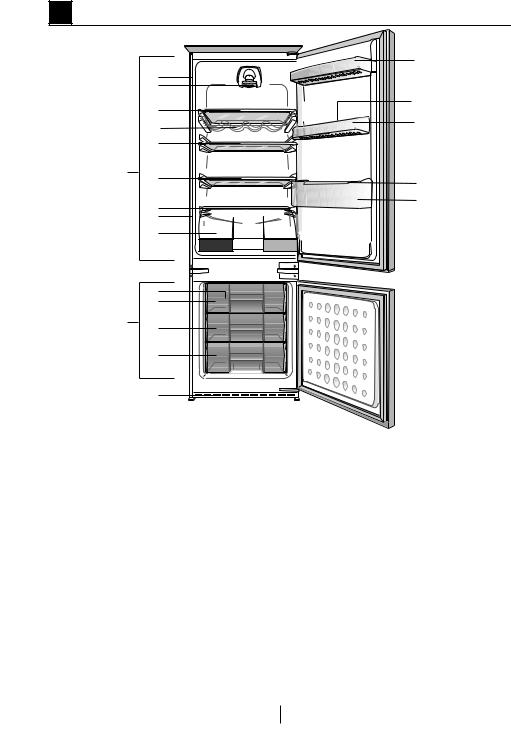
1 Холодильник |
|
|
10 |
1 |
|
2 |
|
|
11 |
3 |
|
13 |
10 |
|
|
3 |
|
14 |
|
3 |
13 |
|
|
5 |
12 |
|
|
4 |
|
6 |
|
7
8
15 |
8 |
|
|
|
8 |
|
9 |
1. |
|
9. |
• • |
2. |
•€ |
10. |
• |
3. |
|
11. |
• • |
4. |
– |
12. |
• |
|
|
13. |
Держатель для бутылок |
5. |
|
14. |
• |
|
|
15. |
|
6.0°C
C • • • - €
. ‚ ,
- ,
- -.
3 RU
